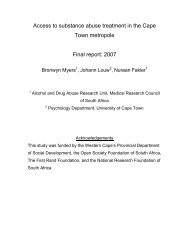Audit of Substance Abuse Treatment Facilities in ... - SA HealthInfo
Audit of Substance Abuse Treatment Facilities in ... - SA HealthInfo
Audit of Substance Abuse Treatment Facilities in ... - SA HealthInfo
- No tags were found...
Create successful ePaper yourself
Turn your PDF publications into a flip-book with our unique Google optimized e-Paper software.
facilities have wait<strong>in</strong>g lists, with an average <strong>of</strong> 6 clients wait<strong>in</strong>g for an available treatmentslot. On average, the wait<strong>in</strong>g period for a treatment slot / bed is 6 days. It should be notedthat none <strong>of</strong> the facilities <strong>in</strong> the Northern Cape reported us<strong>in</strong>g a wait<strong>in</strong>g list.Despite the fact that these wait<strong>in</strong>g periods are much shorter than those identified <strong>in</strong> otherprov<strong>in</strong>ces, such as Gauteng and KwaZulu-Natal (Myers & Fakier, 2007), the presence <strong>of</strong>wait<strong>in</strong>g lists is still worrisome as they may act as a barrier to access<strong>in</strong>g substance abusetreatment (Grant, 1997; Hser et al., 1998; Tucker et al., 2004). Timely access is importantfor facilitat<strong>in</strong>g treatment entry as many substance abusers are ambivalent about seek<strong>in</strong>gtreatment and may have little tolerance for wait<strong>in</strong>g for the next available treatment slot(Kaplan & Johri, 2000).F<strong>in</strong>d<strong>in</strong>gs reflect that facilities <strong>in</strong> Mpumalanga have the lowest treatment occupancy rates,with these facilities operat<strong>in</strong>g, on average, at 38.3% <strong>of</strong> their capacity.4.1.3. Effective use <strong>of</strong> available treatment slotsIn this study, the effective use <strong>of</strong> available treatment slots is <strong>in</strong>dicated by the degree towhich clients are reta<strong>in</strong>ed <strong>in</strong> treatment. Client retention rates differ broadly acrossfacilities, with some facilities report<strong>in</strong>g retention rates as low as 30.0%. On average,facilities reta<strong>in</strong> about 70.2% <strong>of</strong> their clients <strong>in</strong> treatment. The large variation <strong>in</strong> theseretention rates po<strong>in</strong>ts to significant room for service improvement, especially as clientretention is an important proxy <strong>in</strong>dicator <strong>of</strong> service effectiveness and positive treatmentoutcomes.4.2. RANGE AND DIVERSITY OF SERVICES PROVIDEDDespite grow<strong>in</strong>g evidence <strong>of</strong> an association between the availability <strong>of</strong> ancillarytreatment services (e.g. psychological and medical care) and treatment outcomes, andevidence-based practice guidel<strong>in</strong>es that emphasise the need to <strong>in</strong>tegrate ancillary medicaland mental health services with core addiction services (Durk<strong>in</strong>, 2002; Lee et al., 2001),f<strong>in</strong>d<strong>in</strong>gs suggest that substance abuse treatment facilities <strong>in</strong> South Africa generally fail tomeet this standard. In Free State, Limpopo, Mpumalanga, North West and NorthernCape, clients are provided with ancillary medical and mental health-oriented servicesmuch less frequently than core addiction services. This is similar to f<strong>in</strong>d<strong>in</strong>gs from66
















